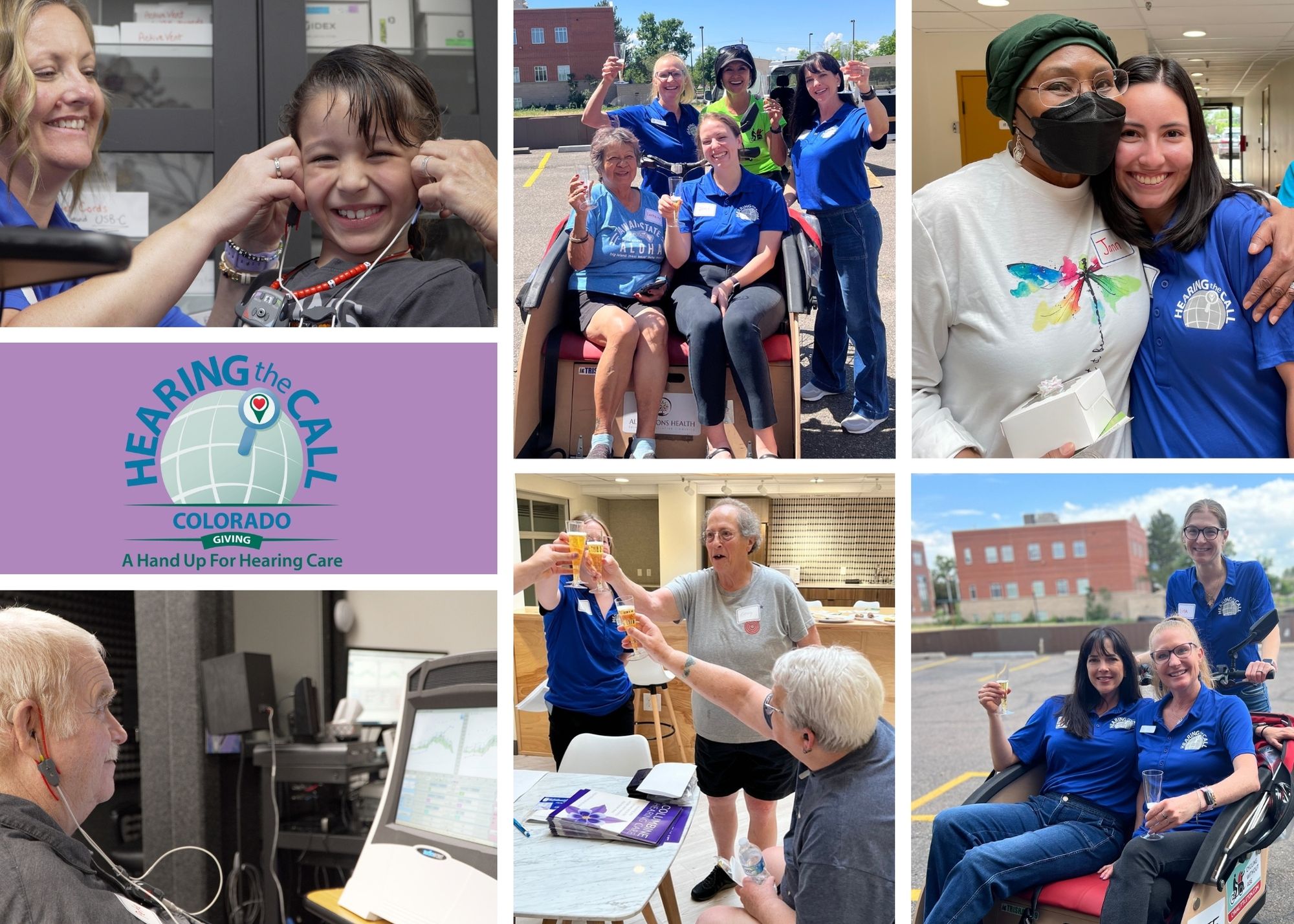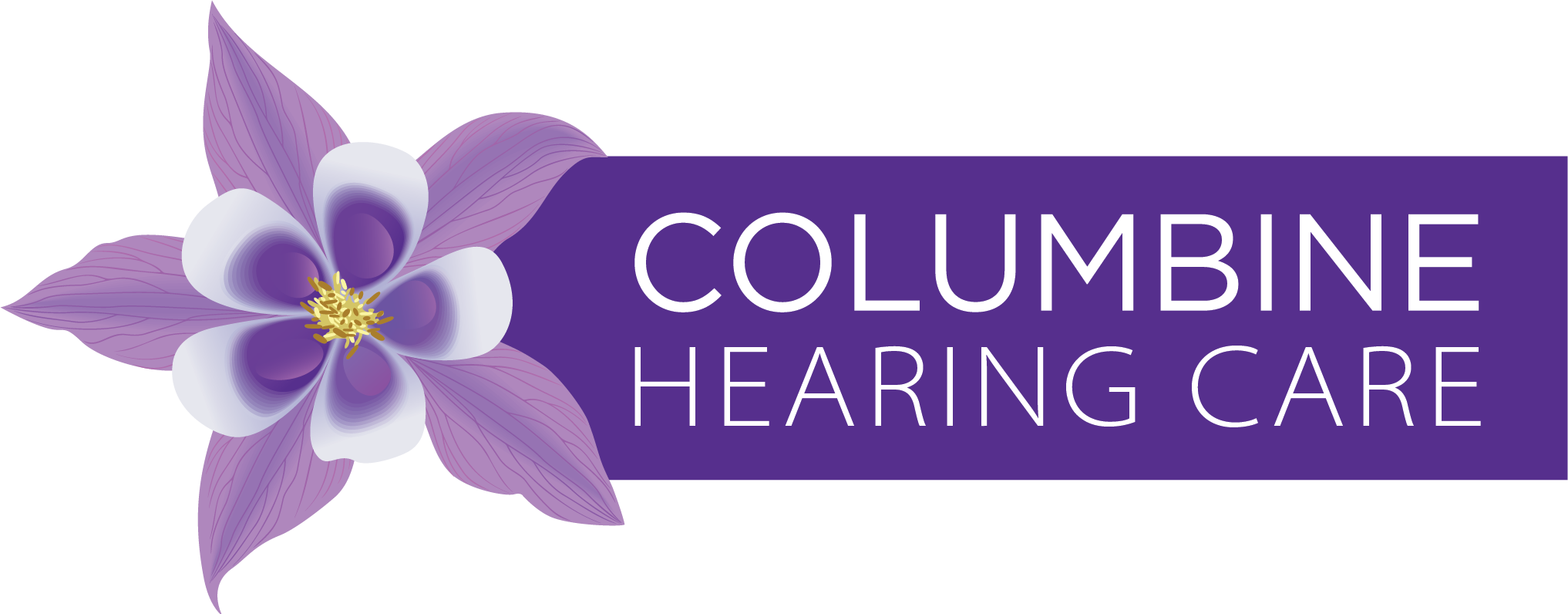-
- A desperate mother made the dangerous journey from Venezuela to the U.S. to allow her 9-year-old daughter to hear for the first time.
- A 96-year-old woman can finally hear her family, be included in conversations, and be treated with the dignity and respect she deserves.
- A 19-year-old student can now hear the professors and follow her dream to earn a college degree and become a school teacher.
We were so blessed to partner with Cycling Without Age Littleton (CWAL) who took our recipients on Trishaw rides along the Platte River Trail where they could hear the beautiful sounds of nature and enjoy a celebratory toast 🥂 of sparkling cider.
Lives were changed this day – not just the lives of those we served, but the lives of every volunteer who got to see the amazing transformation that happens when a person is able to hear again. 💜🫶🏼

Office Updates
📱 New Phone Number for Texting! 📱
Columbine Hearing Care has added a new method of sending text messages that is HIPAA-compliant and saves the messages in your chart for easy access and recall. Please add the following number to your approved contacts list: 720-706-1089.
Note: We will only text you if you have agreed to receive texts on your intake paperwork. Please let us know if you prefer to opt out of texting.
Upcoming Events
If you or someone you know could use a hand up to receive hearing healthcare, Dr. Dusty will be hosting a Hearing the Call “Better Together Simultaneously” hearing aid fitting event at Columbine Hearing Care on August 2, 2024. 🦻🏼
Visit the Hearing the Call – Colorado website HERE for more information, eligibility requirements and the application. Please reach out to Lisa if you have any questions: 720-689-7989.
What is Auditory Rehabilitation?
Nancy Tye-Murray, PhD, defines auditory rehabilitation (AR) as “intervention aimed at minimizing and alleviating the communication difficulties associated with hearing loss.” This definition is fairly broad as the possibilties to achieve this are countless!
Topics often covered in AR include: understanding one’s hearing loss; use and care of hearing aids or other devices; lipreading/speechreading; modifications in the home or work environment; and improving one’s ability to hearing in the presence of background noise.
How is it performed?
Hearing aids are a great place to start, but they cannot fix ALL of your hearing difficulties; you have to put in a little work and change a few bad habits you’ve picked up over the years! 🤣 If you have been fit with hearing aids by Dr. Dusty or Brenda, you have likely received the 5 Keys Communication Handbook, been enrolled in the 5 Keys Online Communication Training Program, or downloaded the 5 Keys Mobile App. All of these options contain mini lessons detailing ideal communication strategies for those with hearing loss and their loved ones or communication partners. It contains information and helpful hints for listeners and speakers to promote successful communication in a variety of common environments (such as the great outdoors, at a restaurant, in a workplace, etc.).
A sampling of topics includes:
- Where to Sit in the Car 🚙
- Clarifying Questions on the Phone 📞
- When & Where While Dining Out 🍽
- Hearing Loops at Public Events 🎥
This is one terrific example of auditory rehabilitation that is effective, easy, user-friendly and available with your hearing aid purchase.
What is the goal?
Goals of auditory rehabilitation include resuming one’s participation in activities that were limited due to their hearing loss (example: re-joining the weekly card club or actively participating in a staff meeting), teaching communication partners methods to appropriately engage with those with hearing loss, improving the flow of conversation and reducing hearing-related disability.
Are there other options?
Audiology clinics may offer in-person auditory rehabilitiation classes (keep an eye on the Columbine Hearing Care Facebook page for class announcements!) or one-on-one sessions with your hearing care provider. If you need more assistance with improving your communication with loved ones, please speak with Dusty or Brenda at your next visit. This topic is near and dear to our hearts and we believe providing AR is one of many components to following audiology best practices. 💜
Click the link below 👇🏼 to read more about AR from the American Speech-Language-Hearing Association (ASHA).
Patient of the Month
Each month we choose one patient who is willing to share their hearing loss journey with us. Meet Scott, our June Patient of the Month! Please take 4 minutes to watch the video below. You might just relate to Scott’s story! We also encourage you to share this video with anyone in your life who has been hesitant to move forward with hearing aids. Scott is very vulnerable as he describes how hearing loss affects his life, and what it was like getting hearing aids for the first time.
Thank You Scott🙏😍🙏
Brenda’s Sound Bites
What You Need to Know About Ear Pressure Changes
With summer upon us, travel plans are in full swing for the Columbine Hearing Care team. ☀️✈️ Speaking from experience, nothing ruins a trip like having ear pain before, during or after flying! Let’s go over some tips and remedies to ensure you have yEAR-round comfort when traveling.
Our ears are remarkable organs that do more than just facilitate hearing; they also play a crucial role in maintaining our sense of balance and regulating pressure changes. This regulatory function is essential for our overall well-being, especially as we age.
To understand how our ears regulate pressure, it’s helpful to know a bit about their anatomy. The ear is divided into three parts: the outer ear, the middle ear, and the inner ear. It’s important to state there are many functions of the middle ear, but I’d like to focus on just one part of the middle ear: the Eustachian tube.
The Eustachian Tube and How it Works
A critical component of the middle ear system is the Eustachian tube. It is a narrow canal that connects the middle ear to the back of the throat. Its primary function is to equalize the pressure between the middle ear and the external environment.
When the pressure inside the middle ear is different from the outside pressure, it can cause discomfort, hearing difficulties, and in some cases, pain. 😣 The Eustachian tube helps prevent these issues by allowing air to flow in and out of the middle ear, thus equalizing the pressure. Though it remains closed most of the time, the Eustachian tube opens when we swallow, yawn, or chew. This opening allows air to pass through, balancing the pressure on both sides of the eardrum.
For example, when you’re in an airplane and it takes off or lands, the rapid change in altitude can lead to a significant difference in pressure. You might feel your ears “pop,” which is the sound of the Eustachian tube opening to let air in or out to equalize the pressure.
Age-Related Changes
As we age, the Eustachian tube can become less efficient due to changes in its structure and function. It may not open as easily or as often, leading to more frequent feelings of ear fullness, discomfort, or even mild hearing loss.
Additionally, the muscles that control the opening of the Eustachian tube can weaken with age, making it harder to balance ear pressure. This is why older adults often experience more difficulties with pressure changes, especially when flying or driving over those mountain passes.
Tips for Managing Ear Pressure
- Stay Hydrated: Keeping your nasal passages moist can help keep the Eustachian tubes functioning properly. Drink plenty of fluids, especially when traveling.
- Use Special Earplugs: Earplugs designed for air travel, (Earplanes), can slow the rate of pressure change, making it easier for your ears to adjust.
- Swallow and Yawn Frequently: These actions help open the Eustachian tubes and can relieve pressure. Easy hack: try a stick of chewing gum!
- Try the Mini Valsalva Maneuver: While pinching your nostrils shut and keeping your mouth closed, simply swallow. DO NOT pinch your nose and force air through by blowing. The goal is to gently open the Eustachian tubes, NOT blow out an eardrum!
- Schedule an Appointment: There is a specialized test that we can perform in the office that gives us insight about your unique Eustachian tube function. If you frequently experience ear discomfort or pressure issues, please schedule an appointment with us ASAP. Occasionally, we may need to refer you to an ENT (ear, nose and throat) doctor to provide more tailored medical advice. Either way, we are here to help!!
By taking proactive steps, we hope to minimize the possibility of ear discomfort on your future adventures. ⛰️
Cheers to Better Hearing!
Brenda
